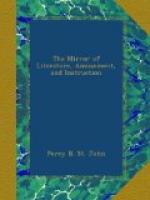The same gentleman also showed me a set of Apostle-spoons, which, although objects of curiosity, had, in conformity with the prevailing fashion, undergone the alteration of the silversmith. There were twelve of them, each of which represented an Apostle, boldly carved on the handle; a large round hat is placed on each of their heads, which was probably to save the features from being injured. They are standing on the stem of the spoon, which is carved somewhat like a Doric pillar. The bowls are very large and deep, and are rather awkwardly turned in at the sides. A complete set, in good condition, is very rare and valuable; and it is to be regretted that so many of these relics have fallen into the silversmith’s furnace, merely for the sake of their silver.
Apostle-spoons were presented by sponsors or visiters at christenings and at marriages; and those who could not afford a complete set, gave one or two, as their circumstances might permit. Some presented a spoon with the figure of the saint after whom the child was baptized, or to whom it was dedicated. In his “Bartholomew Fair,” Ben Jonson has a character to say, “And all this for a couple of apostle-spoons and a cup to eat caudle in.” Likewise in the “Noble Gentleman,” by Beaumont and Fletcher,
“I’ll be a gossip, Bewford—
I have an odd apostle-spoon.”
In “The Gossips,” a poem, by Shipman, in 1666, there is the following mention of the custom of presenting apostle-spoons at christenings, which it appears was then on the decline:—
“Formerly, when they used to troul Gilt bowls of sack, they gave the bowl Two spoons at least—an use ill kept; ’Tis well if now our own be left.”
On St. Paul’s, or any other apostle’s day, it was usual for persons of quality to send round a present of a spoon with the figure of such apostle to their friends. In some Catholic families these and the before-mentioned customs are still retained, though I question whether the spoons are enriched with such superb workmanship.
W.H.H.




